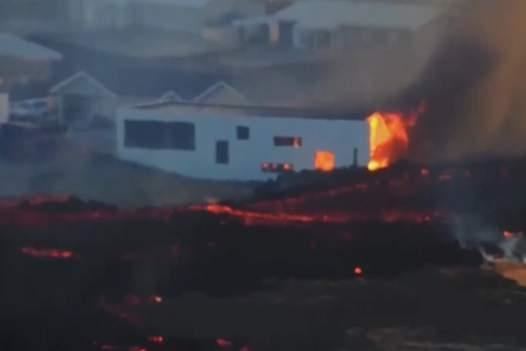The eruption started just before 8 a.m. local time on Sunday morning. At night, blaring sirens woke residents of the fishing town of Grindavik to warn them of the impending eruption. The residents had to leave their homes again. It was only December that lava spewed out of a fissure in the earth’s crust near the town. “We woke up around 3 a.m. to the sound of sirens and checked our phones,” a resident told public broadcaster RÚV. “When we heard there was an evacuation, we got up, packed our things and left. Of course that’s not nice, but when we felt the earthquakes, we knew we had to leave immediately.”
© AFP
“The city was successfully evacuated and no lives are in danger,” wrote Icelandic President Gudni Th. Jóhannesson on X, the former Twitter. But he also immediately reported that infrastructure could be threatened. Air traffic to and from Iceland’s Keflavik airport is not affected by the eruption, as no ash is spewed into the air.
Follow the eruption live via the video below
The fissure is now estimated to be 1 kilometer long, which is shorter than the December eruption. Then the crack measured about 4 kilometers. But this new “fissure eruption” is no less dangerous. This time the lava flows towards the fishing town. The Icelandic meteorological service reported on Sunday morning via channel RUV that the lava is a few hundred meters from the city. The lava reached the first houses around 3 p.m.
Live images from national channel RÚV show that several houses are on fire. However, most of the eruption’s lava is flowing away from the town, thanks to protective walls built around Grindavik, Iceland’s weather services say. Mayor Fannar Jonasson called the eruption a “major and serious shock to the population.” “This doesn’t look good because the lava has to travel a relatively short distance to reach the city.”
© AFP
“This new volcanic eruption is a greater threat to the town than the one in December,” says Karen Fontijn, volcanologist at the ULB. “In December the eruption also occurred northeast of Grindavik, but a little further away. Then the lava flowed away from the city. Now she’s flocking to it.”
Was it expected that the volcano would erupt again after December?
“Yes. In December, only a small part of the magma that was accumulating in the earth’s crust emerged (once magma is out of the ground, it is called lava, ed.). We do not know why the outbreak did not last longer.”
“The Icelandic agency warned last week that there was a lot of magma in the upper part of the earth’s crust again and a new outbreak was likely.”
Can the residents of Grindavik rest easy when all the magma from the upper part of the Earth’s crust is removed?
“Unfortunately not. The threat will not stop after these eruptions.”
How can we know that?
“The peninsula lies on a whole system of faults along which magma can rise from great depths. And we can deduce a lot from the volcanic history of the peninsula. The various hardened lava flows on the peninsula have been very well studied. Their age was analyzed layer by layer. This shows that throughout history there were long, quiet periods with little volcanic activity on the peninsula and then periods of very high volcanic activity.”
“The quiet phases always lasted long: between 800 to 1,000 years. This was followed by periods with many volcanic eruptions. In the past, these periods of high activity lasted several decades. A period of high volcanic activity has begun in 2021.”
And will it last decades?
“Yes. This now makes crisis management in Iceland very complex. Because it is difficult to evacuate the residents of Grindavik again and again over such a long period of time when another eruption is coming. The government will have to consider permanently evacuating residents.”
“Don’t underestimate the impact for Iceland. Grindavik has 3,000 inhabitants. To us it seems like a small town. But this amounts to 1 percent of the entire population of Iceland. That’s as if you had to evacuate or resettle more than 100,000 people in Belgium. The same goes for the port of Grindavik: it is small by our standards, but for Iceland the port is important.”
The village also had to evacuate a few days before Christmas. — © AFP
© via REUTERS
